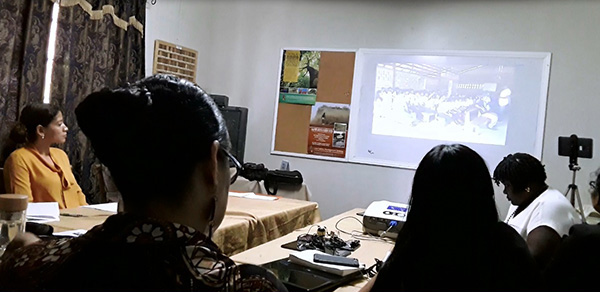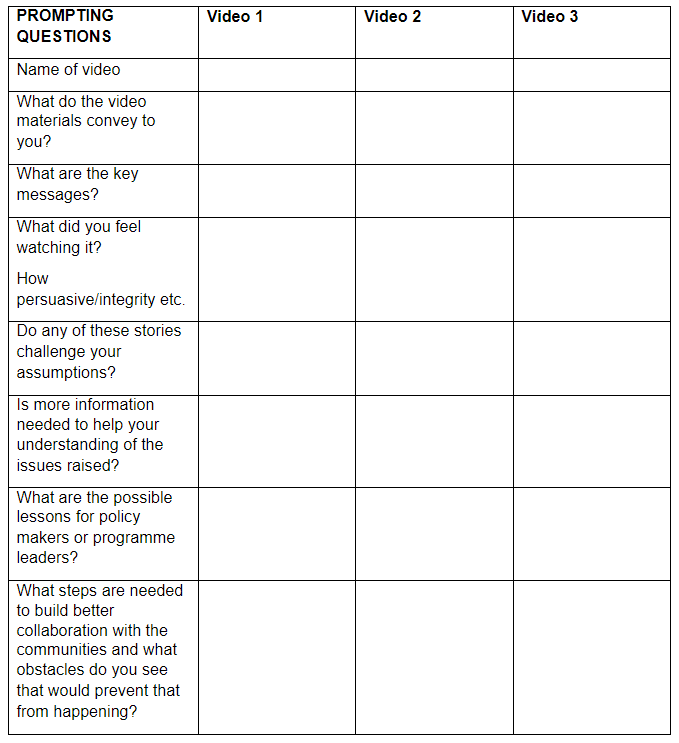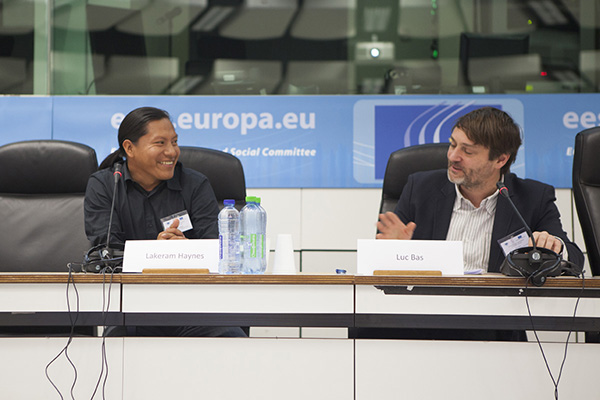Video mediated dialogue
| Site: | OpenLearn Create |
| Course: | 7 Integrating community monitoring and management into frameworks of policy and management |
| Book: | Video mediated dialogue |
| Printed by: | Guest user |
| Date: | Sunday, 23 November 2025, 5:09 AM |
Description
1. Introduction
Video-mediated dialogue is a two-way communication based on participatory videos produced by communities, which are screened to decision-makers which then leads to the development of a response video, which is subsequently taken back to communities for feedback (which could initiate another round of filming, screening and feedback if required) (Mistry and Shaw 2021).
2. First steps
Step 1 - Video production
Videos of community owned solutions, community challenges and monitoring results produced in Unit 6 are produced by communities to share with decision-makers.
These videos were made by community researchers in the North Rupununi, Guyana about traditional knowledge, its role in biodiversity conservation, and the relationship between Indigenous communities and the Iwokrama International Centre who manages the Iwokrama Forest protected area.
Videos: https://vimeo.com/showcase/
Step 2 - Pre-screening preparation
Before screening the community videos to decision-makers it is useful to have a pre-screening discussion with your community or the community you are working with to clarify any issues or themes arising from the community videos, and to identify any implications for the screening. The following questions can be used as a guide to shape the discussion and to help direct the engagement (Shaw 2017). The questions in bold are often the most important to consider:
- What is the purpose of the engagement? Are you aiming to connect decision-makers with the reality of your situation, deliver a message, provoke them to think, or inspire them to act?
- How will you identify and find the most appropriate decision-makers to engage with? Can you find those with the power to implement change?
- Do you have any contacts in influential positions who champion your cause and will help you build relationships? If not, how will you find people to support you?
- How will you invite decision-makers and explain how you will engage with them so that they are motivated to come and know what to expect?
- Will your community members be involved or someone on their behalf?
- What are the advantages and disadvantages of having help from external partners (e.g. national and international NGOs, media organizations, project intermediaries)?
- How will you communicate with decision-makers? Ideally you build mutual trust and collaboration whilst, if needed, speaking truth to them, or calling them to account?
- Are there likely to be negative or unexpected reactions? How will you stop potential risks to vulnerable community members?
- How can you build on an initial exchange to generate future collaborations?
- What are your plans for following up promises and offers made by decision-makers during the exchange?
- How can you encourage active commitment on the part of decision-makers to support community-led change?
3. Screening events
Next it is important to produce a screening schedule to make sure the roles and responsibilities of the community presenters are clear. It can also be useful to develop a series of questions to send to decision-makers ahead of the screening, about the topic you want to discuss, to assess current knowledge and opinions of the themes that will come up in the videos.
This video provides an overview of collating the videos made by community researchers in the North Rupununi, Guyana and showing them to the decision-makers.
Step 3 – video screening event
The screening can either be face-to-face at an arranged meeting or via an online meeting. The meeting should start with a short introduction including the aim of the screening (to build mutual understanding of issues/concerns and inspire decision-makers to act on the videos), and an outline of the process. All participants should be given the opportunity to ask questions about the videos and the topics covered in them.

A short exercise should then be undertaken to get decision-makers familiar with the participatory video process, instructing them how to record a video. The focus of the exercise should be for them to introduce themselves, talk a little about what they do in the institution.
Community videos should then be screened one at a time to allow discussion in between. Decision-makers attending the meeting should then be provided with a sheet of questions (Table – Example Questions, below) to help guide thinking as they watch and listen to the issue(s) and views of those documented in community videos.

Step 4 – Documenting decision-maker responses
At the end of the screening event, arrangements should be made to film responses of the people attending the event to the community videos. These should be compiled into one video, and a draft shared with the participants for feedback (by day 5 after the screening/interviews). Feedback should be recorded and used to produce a final version of the video to distribute to the communities.
4. Response and ongoing collaboration
Step 5 – Screening of decision-maker response videos to communities
A face-to-face meeting or online meeting should be held with the community to screen the decision-maker responses to the community videos. It is important to organise a schedule for the meeting, including an introduction, screening of the community videos (this is only necessary if community members have not previously seen the videos) and a screening of the decision-makers’ responses. A discussion should then be facilitated to determine what actions need to be then undertaken by the community. This might involve the production of additional videos to start another round of information exchange.
As part of a process of video-mediated dialogue, this video documents the response of the Iwokrama International Centre and the Ministry of Amerindian Affairs to the community videos from the North Rupununi, Guyana. This video was taken back to communities for feedback and to continue the dialogue.
Step 6 – Information analysis
The information collected as part of the process consists of the community videos, pre-screening questionnaires, the discussions during the screenings, the response videos and the screenings back to the communities. All of this information should be reviewed to determine themes, management actions and policy recommendations. The key themes, management actions and policy recommendations should then be shared back with your community or the community you are working with and the decision-makers you have engaged with.
Step 7 – Ongoing collaboration
The process of engagement should have developed a starting point of communication between your community, or the community you work with, and decision-makers. It is important that this collaboration is continued and built upon. Agreeing a timetable and the way you will communicate in the future is important, so that the collaboration goes forward smoothly. It is also a good idea to regularly produce community owned solution videos, identify new challenges facing the community and present monitoring results so community management and monitoring can inform policy and government management actions.
